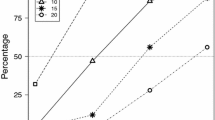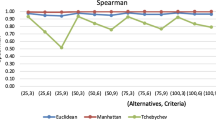Abstract. The authors consider the problem of determining the values of collective expert evaluation of alternative decisions on the basis of models whose structure is described by fragments of the Kolmogorov–Gabor polynomial. The approach is proposed that allows us to formalize the uncertainly of the definition of model parameters of multifactor evaluation based on fuzzy intervals; to define collective fuzzy estimates of alternatives and use them to range the alternatives in accordance with the decomposition of fuzzy intervals at the α-levels.
Similar content being viewed by others
References
A. N. Kolmogorov, “Representing continuous functions of several variables as superpositions of continuous functions of one variable and addition,” Dokl. AN USSR, 5 (114), 953–956 (1957).
E. Petrov and K. Petrov, Comparator Identification of Models of Multifactor Evaluation, Palmarium Academic Publishing, Saarbrucken (2013).
N. V. Diligenskii, L. G. Dymova, and P. V. Sevastyanov, Fuzzy Modeling and Multicriteria Optimization of Industrial Systems under Uncertainty: Technology, Economy, Ecology [in Russian], Mashinostroenie, Moscow (2004).
L. Jaulin, M. Kieffer, O. Didrit, and E. Walter, Applied Interval Analysis with Examples in Parameter and State Estimation, Robust Control and Robotics, Springer-Verlag, London (2001).
V. V. Kryuchkovskii, E. G. Petrov, N. A. Sokolova, and V. E. Khodokov, Introspective Analysis. Methods and Tools of Expert Evaluation [in Russian], Grin’ D.S., Kherson (2011).
Yu. P. Zaichenko, I. O. Zaets, A. V. Kamotskii, and E. V. Pavlyuk, “Investigating different types of membership functions of parameters of fuzzy predictive models in the fuzzy group method of data handling,” USiM, No. 2, 56–67 (2003).
A. Piegat, Modelowanie i Sterowanie Rozmyte [in Polish], Warszawa (2000).
X. Wang and E. E. Kerre, “Reasonable properties for the ordering of fuzzy quantities (I), (II),” Fuzzy Sets and Systems, No. 122, 375–385, 387–405 (2001).
P. V. Sevastyanov and A. V. Venberg, “A constructive procedure to compare fuzzy numbers and its application in optimization problems,” in: Proc. 7th Intern. Conf. Information Networks, Systems, and Technologies (BGEU, October 2–4, 2001), Vol. 3, Minsk (2001), pp. 52–57.
J. Banas and M. Machovska-Szewczyk, “Method of putting trapezoidal fuzzy number in order,” in: Proc. 6th Intern. Conf. Advanced Computer Systems, Technical University of Szczecin, Szczecin (1999), pp. 175–179.
P. V. Sevastjanov and P. Rog, “A probabilistic approach to fuzzy and crisp interval ordering,” Task Quarterly, 7, No. 1, 147–156 (2003).
Author information
Authors and Affiliations
Corresponding author
Additional information
Translated from Kibernetika i Sistemnyi Analiz, No. 2, March–April, 2016, pp. 107–115.
Rights and permissions
About this article
Cite this article
Ovezgeldyev, A.O., Petrov, K.E. Fuzzy-Interval Choice of Alternatives in Collective Expert Evaluation. Cybern Syst Anal 52, 269–276 (2016). https://doi.org/10.1007/s10559-016-9823-4
Received:
Published:
Issue Date:
DOI: https://doi.org/10.1007/s10559-016-9823-4




